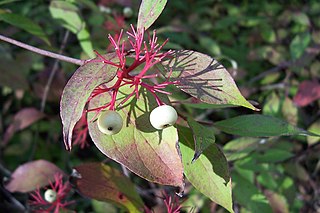
Cornus sericea, syn. C. stolonifera, Swida sericea, red osier or red-osier dogwood, is a species of flowering plant in the family Cornaceae, native throughout northern and western North America from Alaska east to Newfoundland, south to Durango and Nuevo León in the west, and Illinois and Virginia in the east. It has sometimes been considered a synonym of the Asian species Cornus alba. Other names include red brush, red willow, redstem dogwood, redtwig dogwood, red-rood, American dogwood, creek dogwood, and western dogwood.

August Wilhelm Eichler, also known under his Latinized name, Augustus Guilielmus Eichler, was a German botanist who developed a new system of classification of plants to reflect the concept of evolution. His author abbreviation in botany is Eichler.
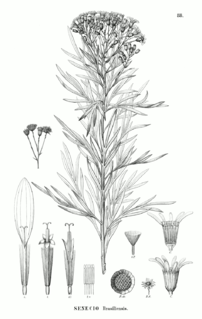
Flora Brasiliensis is a book published between 1840 and 1906 by the editors Carl Friedrich Philipp von Martius, August Wilhelm Eichler, Ignatz Urban and many others. It contains taxonomic treatments of 22,767 species, mostly Brazilian angiosperms.
Dicliptera mucronifolia is a plant that is native of Cerrado vegetation in Brazil. This plant is cited in Flora Brasiliensis by Carl Friedrich Philipp von Martius.
Geissomeria longiflora is a plant native to the Cerrado vegetation of Brazil. This plant is cited in Flora Brasiliensis by Carl Friedrich Philipp von Martius. In addition, this plant grows in Porto Seguro city, state of Bahia, and Viçosa city, state of Minas Gerais.

Dicliptera is a genus of flowering plants in the bear's breeches family, Acanthaceae. Well-known synonyms include Peristrophe and Dactylostegium.

Jacksonia sericea, commonly known as Waldjumi, is a species of low-spreading shrub or small tree that occurs in the south west of Western Australia. Found on the Swan Coastal Plain, it grows to 0.6m, has orange flowers from December to February and grows in calcareous and sandy soils. It has a Priority Four classification on the Department of Parks and Wildlife's Declared Rare and Priority Flora List.
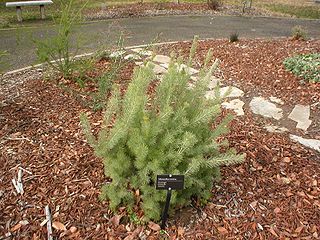
Adenanthos sericeus, commonly known as woolly bush, is a shrub native to the south coast of Western Australia. It has bright red but small and obscure flowers, and very soft, deeply divided, hairy leaves.
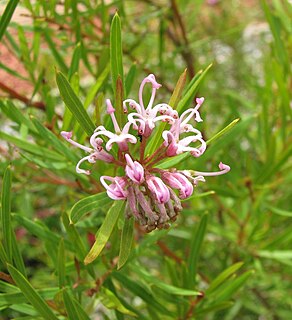
Grevillea sericea, commonly known as the pink spider flower, is a shrub endemic to New South Wales, Australia.
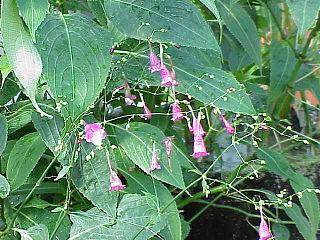
Peristrophe was a genus of up to 40 species of flowering plants: that are now usually considered synonyms in the genus Dicliptera Juss.
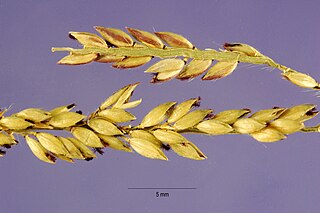
Eriochloa is a widespread genus of plants in the grass family, commonly called cupgrass. They are found across much of Africa, Asia, Australia, and the Americas, plus a few places in European Russia.

Hakea sericea, commonly known as bushy needlewood or silky hakea, is a large shrub with a profusion of mainly white flowers from July for several months. It is endemic to eastern Australia. It has become an environmental weed in some countries.

Balsamorhiza sericea is a species of flowering plant in the sunflower tribe of the plant family Asteraceae known by the common name silky balsamroot. It is native to the Klamath Mountains of northwestern California and southwestern Oregon, with additional populations in the Blue and Steens Mountains in eastern Oregon. It grows in rocky areas, sometimes on serpentine soils.
Dicliptera aripoensis is a species of plant in the family Acanthaceae which is endemic to Trinidad and Tobago. The species is only known from the Heights of Aripo, in Trinidad's Northern Range. It is a branching shrub, 1–1.5 m tall with red flowers about 3 cm long.

Adenanthos macropodianus, commonly known as gland flower, or Kangaroo Island gland flower, is a species of shrub in the family Proteaceae. It is endemic to Kangaroo Island in South Australia. First published as a variety of A. sericeus in 1870, it was promoted to species rank in 1978.
Dicliptera maclearii is a species of plant in the family Acanthaceae which is endemic to Christmas Island, an Australian territory in the north-eastern Indian Ocean. Its specific epithet honours John Maclear, captain of the survey vessel HMS Flying Fish, which visited Christmas Island in 1886.
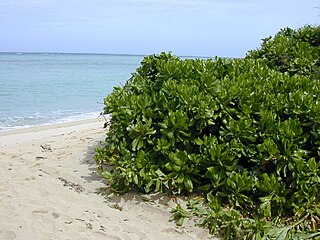
Scaevola taccada, also known as beach cabbage, sea lettuce, beach naupaka, naupaka kahakai (Hawaiian), magoo (Divehi), merambong (Malay), bapaceda or papatjeda, ngahu (Tongan) is a flowering plant in the family Goodeniaceae found in coastal locations in the tropical areas of the Indo-Pacific. It is a common beach shrub throughout the Arabian Sea, the tropical Indian Ocean and the tropical islands of the Pacific Ocean.

Neolitsea sericea is a species of tree in the family Lauraceae. It is found in China, Taiwan, south Korea, and Japan. Its natural habitat is on forest margins and slopes, and it is often found in well-progressed secondary forests.

Dicliptera tinctoria is the accepted name of a species in the family Acanthaceae. It may be called magenta plant, or lá cẩm in Vietnamese and native to southeastern Asia from Assam south to Sri Lanka and east to mainland Southeast Asia, Java, southern China, and Taiwan.















